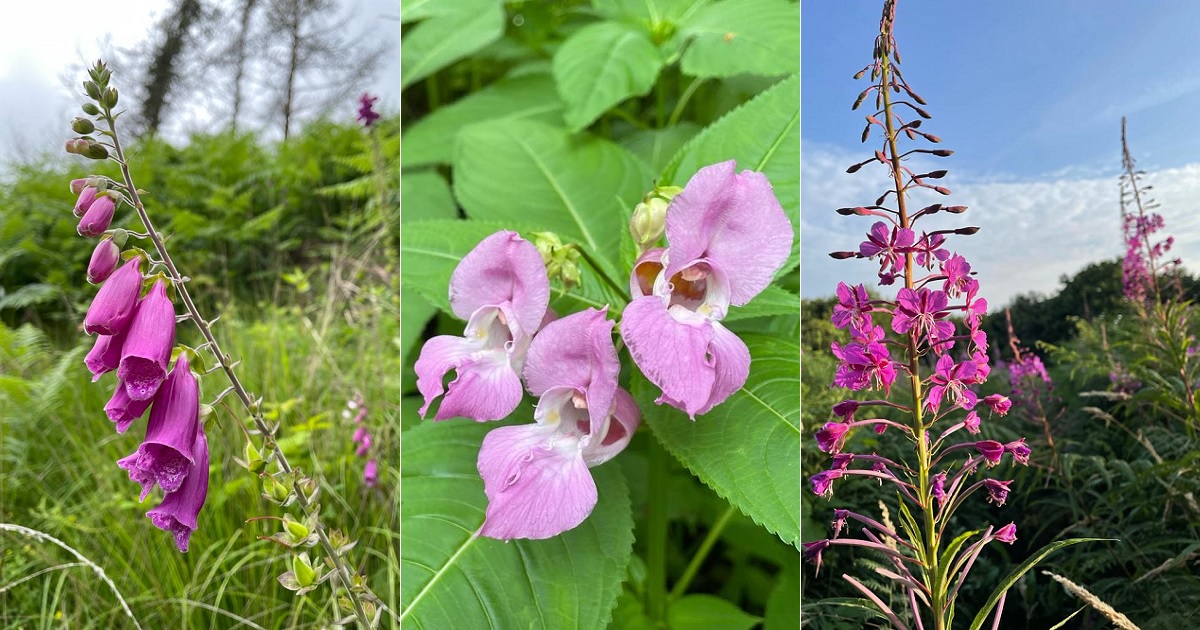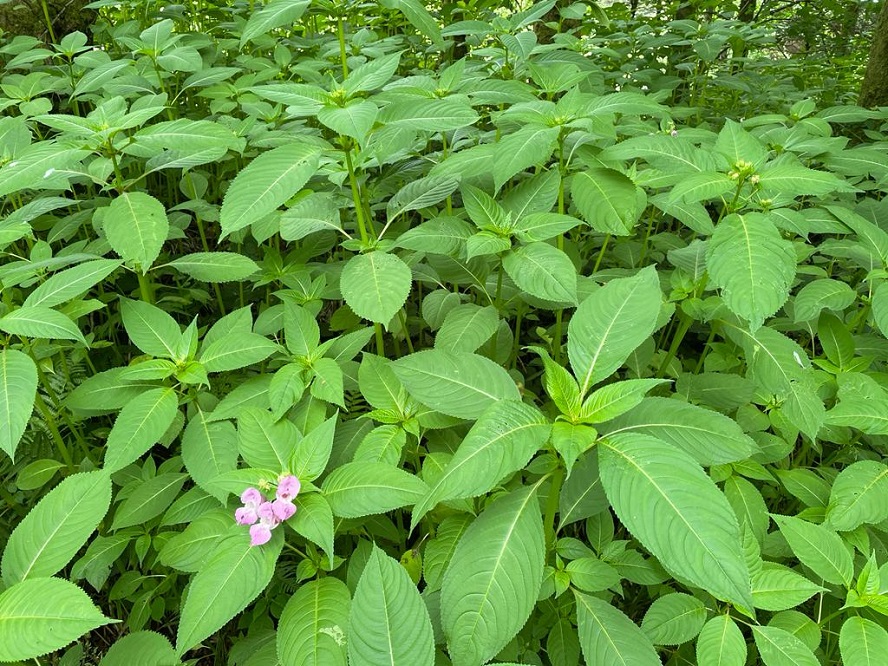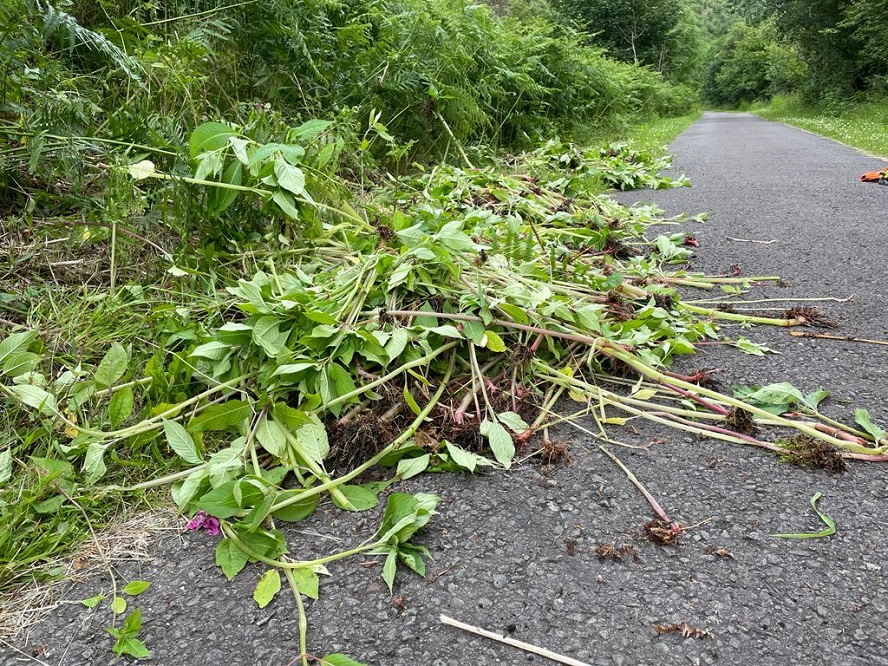In the undergrowth no one can hear you scream: Tawny Clark takes on an alien invader

Tawny Clark
Today’s task is rather curious. Going, as it does, rather against the grain. You expect ‘neat and tidy’ when you step back to admire your handiwork, a calming sense of peace and order after all your efforts.
But this is one job where mess – carnage even – seems the order of the day, and its music to my scruffy ears. If you’re Marie Kondo, best look away now!
The practice of ‘balsam bashing’ seems the ideal task for me to roll up my sleeves and get stuck in. Although, as I quickly discover, rolling sleeves up here is somewhat ill-advised. As is wearing shorts if, like me, you’re a juicy midge-magnet.
It doesn’t have the same fearsome reputation as the dreaded Japanese knotweed, but Himalayan balsam is similarly a non-native, ‘alien’, invasive plant for which we have the Victorians to thank for introducing to Britain.
As its Latin name, Impatiens glandulifera, suggests, Himalayan balsam is indeed a rather ‘impatient’ specimen.
Thanks to its phenomenal, explosive seed pods – which can shoot up to an unbelievable seven metres from the parent plant – it quite literally blasted from gardens and private collections into our countryside, where it’s taken a firm stranglehold in many places.
Growing well over two metres tall, it forms dense swathes of vegetation and outcompetes native plants for light and nutrients, reducing biodiversity as it smothers all in its way.
It’s quite pretty though. Large, fuchsia-pink bell-shaped flowers give rise to common names like Policeman’s helmet and Gnome’s hatstand.
But after the flowers come those pesky seed pods. We need to act quickly before they appear in August as a single plant can release up to eight-hundred seeds. Eek.
Unlike Japanese Knotweed, one positive here is that balsam’s hollow, shallow-rooted stems are incredibly easy to pull out.
No Harry Potter-style screaming Mandrake roots either, you literally grab and pull. Simples.
Balsam bashing
I’ve come to the village of Cymmer, in the Afan Valley, to help a small band of enthusiastic, determined volunteers from the Lost Peatlands project tackle this blight on an otherwise fascinating, species-rich Community Wildlife Site.
Today we’re on a former colliery railway line – now a popular cycle track.
Here, balsam lurks amid high stands of bracken, which teeters on tiptoes to stare-down its unwelcome rival.
Hidden brambles and nettles are ready to surprise an unsuspecting arm. Disturbed midges delight in the bare-skin feast. But, with a few precautions (Jungle Formula and long sleeves), it’s an incredibly satisfying occupation.
The hollow stems lift easily from the soft ground and in no time at all we’ve stripped hundreds of balsam plants from the track line.
Now for the messy part, as the key to success is in preventing the uprooted balsam from touching the ground and re-rooting.
If material isn’t removed from site, a common approach is to hang stems out to dry and die off. We bundle them onto branches and crooks in the trees lining the path and throw a few atop bracken and bramble – rain may weigh them down so care is needed.
Up-rooting is generally a more effective method but hitting stems with sticks to knock off the flowerheads, known as ‘balsam bashing’, is another popular – and really fun – way to prevent seeds forming.
Chemical spraying does untold harm to nature, avoid herbicides, and use your muscles. Much better for you, and the environment.

Alien invader
Whatever method is used, the purpose is to stop the balsam setting seed. Having had a taster, I’m keen to get myself a decent thwacking stick and get out onto my local patch before they appear in the next couple of weeks (August usually).
Maybe it’s the ideal opportunity to unleash my inner Serena Williams and practice my backhand by smashing balsam with a tennis racket?
Anyone can give it a go.
When a passing couple stop to ask what we’re up to, they’re given a swift briefing and encouraged to join the effort by pulling up a few stems on their daily dog walk.
Little and often, that’s what’s needed for a site like this. Regular visitors each doing a small amount would soon clear the site of this invasive species.
It’s a bizarre feeling, somewhere between morbid fascination and sadistic delight, to stand back and observe the gruesome aftermath of our labours.
There are trampled paths through the bracken, gaping holes in stands of vegetation, stems strewn over unfurled fronds, piled high on branches, thrust over crisp, shade-bronzed bramble.
It’s everywhere…except rooted in the ground.
Although it looks a terrible mess, the hope is, with a determined effort from volunteers and local communities, natural habitats across Wales can be reclaimed and native wildlife can thrive once again.
It may seem a thankless, pointless task. It’ll just keep growing back, right? Wrong.
Balsam seeds are only viable for two years, so, if plants are pulled repeatedly before they set seed, there’s potential to eradicate this alien invader from our natural places in only a few seasons.
Yes, there is an awful lot of it, but there are a lot of people too. Many hands and all that.
I’m all warm and fuzzy as we head back.
Resisting the urge to skip as I happily bask in the double-whammy hit of endorphins that comes with combining exercise with nature conservation.

Superficially similar
However, my jollity is short lived. My hands lift instinctively, despairingly, to the sides of my head as I realise what’s littering the path ahead. I embody Edvard Munch’s The Scream. ‘Noooooo!’
The track is strewn intermittently with long, green stems. Their distinctive flower spikes of ‘almost’ fuchsia pink pop vividly against hard grey track.
In their admirable eagerness to help, the amenable dog walkers had diligently uprooted all the balsam-like plants.
In this case, the magnificent native foxgloves, which had been lining the path in all their flowering glory.
Superficially similar in appearance to Himalayan balsam, with tall green stems, purply-pink fairy-hat flowers, foxglove is a valuable nectar-source for pollinators and a treasured native wildflower. It doesn’t have hollow stems though and is harder to up-root.
Native species of willowherb often form dense stands and may also be mistaken for Himalayan balsam. They’re tall too, but with smaller, pink, four-petalled flowers – so perhaps not so readily confused as foxglove.
It’s always advisable to check before uprooting ANY plant.
If you can, it’s worth attending a local event, or get involved with conservation organisations who are always grateful for willing volunteers.
If you have no time, don’t underestimate the positive impact you could make by simply pulling up a few stems (before they seed) as you walk past and slinging them in a tree.
Just be certain what you’re pulling up first.
Support our Nation today
For the price of a cup of coffee a month you can help us create an independent, not-for-profit, national news service for the people of Wales, by the people of Wales.




